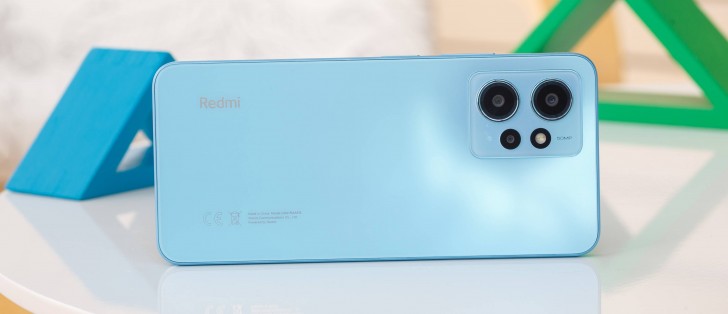Xiaomi Redmi Note 12 4G review

Bright, 120Hz OLED
The Redmi Note 12 4G and the 5G version presumably share the same 6.57-inch AMOLED panel with a standard 1080 x 2400px resolution. The panel is clocked at 120Hz but doesn't comply with any of the HDR video standards and that's okay. This is a low-end smartphone after all.

Still, the panel itself is a unicorn of sorts given the price tag of the Redmi Note 12 4G. With a display like that, the device punches above its price category with only a handful of other OLED-powered options available on the market. And neither of those are clocked at 120Hz, they cap at 90Hz.
The display did well in our testing too. In manual mode, the screen peaked at 474 nits, while Auto mode boosted that to 744 nits, which is almost flagship-grade. Above the 700 nits mark, we can confidently say that the phone will be easy to use even on a bright sunny day. Brightness is more than sufficient.
| Display test | 100% brightness | ||
| Black, |
White, |
||
| 0 | 474 | ∞ | |
| 0 | 744 | ∞ | |
| 0 | 490 | ∞ | |
| 0 | 890 | ∞ | |
| 0 | 427 | ∞ | |
| 0 | 610 | ∞ | |
| 0 | 455 | ∞ | |
| 0 | 647 | ∞ | |
| 0 | 501 | ∞ | |
| 0 | 1015 | ∞ | |
| 0 | 465 | ∞ | |
| 0 | 736 | ∞ | |
| 0.323 | 429 | 1328:1 | |
| 0.405 | 508 | 1254:1 | |
| 0.389 | 519 | 1334:1 | |
| 0 | 473 | ∞ | |
| 0 | 756 | ∞ | |
Color accuracy in the default color mode isn't impressive as it produces a bit blue-ish whites and grays but in the Standard color preset, the average dE2000 goes down to 1.5 in the sRGB color space.
HRR control
There's no smart refresh rate control, and you get only two simple modes - 60Hz and 120Hz. Pretty much all apps and system menus we tried, saturate the full 120Hz refresh rate. Still, playing videos via the native Gallery app or opening a dedicated video app like YouTube brings down the refresh rate to 60Hz as they should.
Battery life
The handset packs a 5,000 mAh battery, which is pretty much the standard these days, especially in this price category. The big battery is coupled with a not-so-demanding Snapdragon 685, so expectedly, battery life is great. Standby is decent enough, the talk time score is pretty good and the video playback runtime is really impressive. It's definitely one of the highest we've seen.

Our battery tests were automated thanks to SmartViser, using its viSerDevice app. The endurance rating denotes how long the battery charge will last you if you use the device for an hour of telephony, web browsing, and video playback daily. More details can be found here.
Video test carried out in 60Hz refresh rate mode. Web browsing test done at the display's highest refresh rate whenever possible. Refer to the respective reviews for specifics. To adjust the endurance rating formula to match your own usage patterns check out our all-time battery test results chart where you can also find all phones we've tested.
However, the web browsing score is surprisingly lower than anticipated, which brings down the overall endurance score a lttile. Still, an overall endurance score of 117 hours is more respectable.
Compared to some of the similarly priced alternatives, the Redmi Note 12 4G falls behind. If battery life is your absolute top priority, there are better options than the 4G Note 12.
Charging speed
The Redmi Note 12 4G fills up its battery using a 33W charging brick and achieves fairly decent charging times. The first 30 minutes will get you 55% of the charge back, while a top-off takes 1 hour and 11 minutes. Both scores seem to be more than adequate for the price range as only more expensive options outperform the Redmi Note 12 4G, namely the Galaxy A23 5G from last year and the higher-tier Redmi Note 12 Pro.
Speaker
Unlike its predecessor, the Redmi Note 12 4G skips on the stereo loudspeaker and relies only on a standard bottom-firing speaker. It does get the job done, as it's not too quiet, but it's far from the Redmi Note 11's loudness and sound quality. It got -27.9 LUFS on our test, earning a "Good" overall score.
Then again, not many competitors have stereo loudspeakers at around €200, so it's hard to complain.
Use the Playback controls to listen to the phone sample recordings (best use headphones). We measure the average loudness of the speakers in LUFS. A lower absolute value means a louder sound. A look at the frequency response chart will tell you how far off the ideal "0db" flat line is the reproduction of the bass, treble, and mid frequencies. You can add more phones to compare how they differ. The scores and ratings are not comparable with our older loudspeaker test. Learn more about how we test here.
Reader comments
- Ribbu
- 17 Mar 2025
- SYx
Low Call quality, performance ok
- Blasone
- 24 Feb 2025
- XKF
Can Redmi Note 12 support SD card 512Gb ?
- Adryann
- 15 Oct 2024
- Ju9
a14 5g (4gb ram / 128gb memory) or a redmi note 12 4g (4gb ram / 128gb storage)?